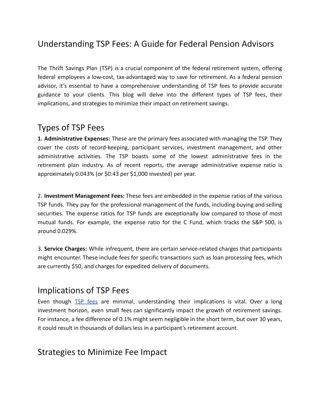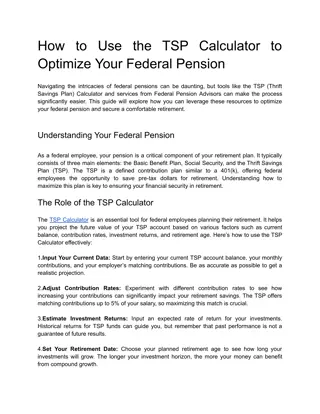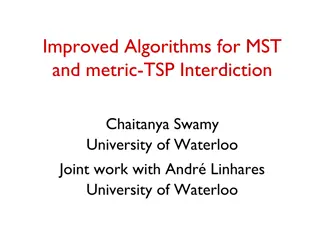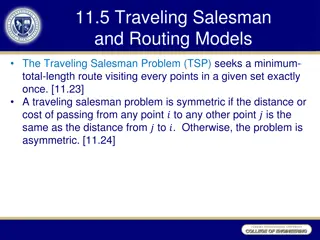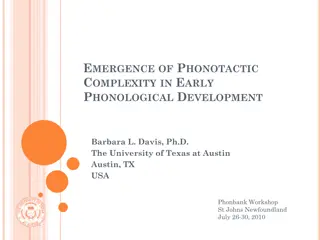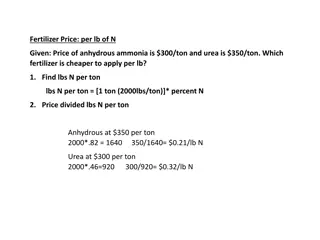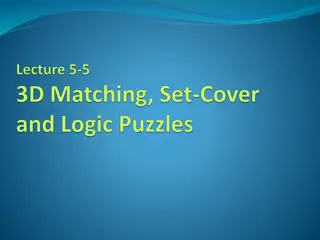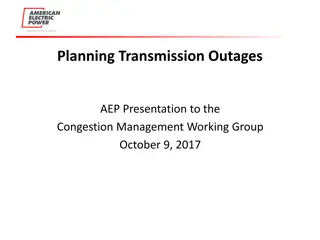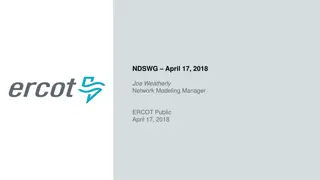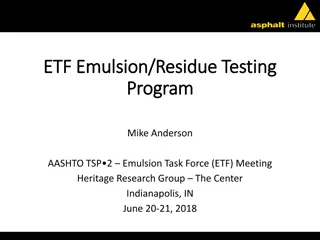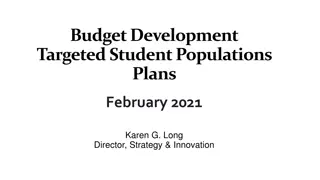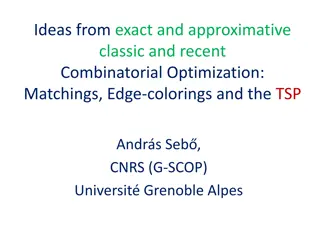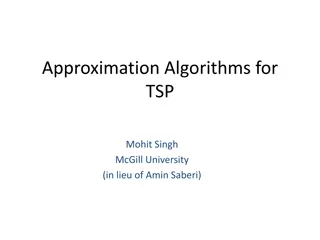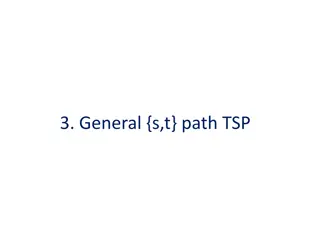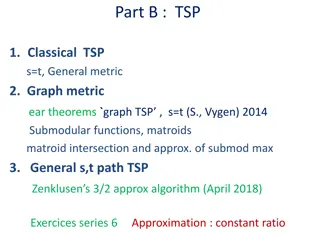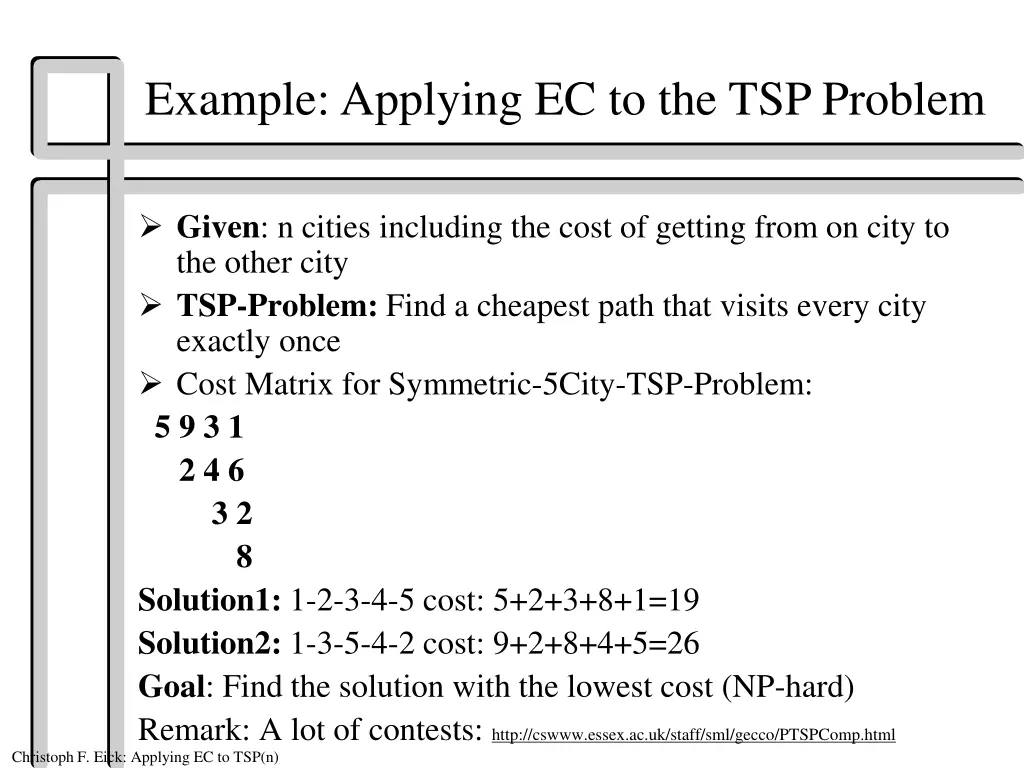
Applying Evolutionary Computation to TSP Problem
"Learn how Evolutionary Computation can be utilized to solve the Traveling Salesman Problem efficiently. Explore key components, the evolutionary cycle, fitness functions, and more with practical examples and strategies." (299 characters)
Download Presentation

Please find below an Image/Link to download the presentation.
The content on the website is provided AS IS for your information and personal use only. It may not be sold, licensed, or shared on other websites without obtaining consent from the author. If you encounter any issues during the download, it is possible that the publisher has removed the file from their server.
You are allowed to download the files provided on this website for personal or commercial use, subject to the condition that they are used lawfully. All files are the property of their respective owners.
The content on the website is provided AS IS for your information and personal use only. It may not be sold, licensed, or shared on other websites without obtaining consent from the author.
E N D
Presentation Transcript
Example: Applying EC to the TSP Problem Given: n cities including the cost of getting from on city to the other city TSP-Problem: Find a cheapest path that visits every city exactly once Cost Matrix for Symmetric-5City-TSP-Problem: 5 9 3 1 2 4 6 3 2 8 Solution1: 1-2-3-4-5 cost: 5+2+3+8+1=19 Solution2: 1-3-5-4-2 cost: 9+2+8+4+5=26 Goal: Find the solution with the lowest cost (NP-hard) Remark: A lot of contests: http://cswww.essex.ac.uk/staff/sml/gecco/PTSPComp.html Christoph F. Eick: Applying EC to TSP(n)
Key Components of an EC System Given: Fitness Function Chromosomal Representation EC Selection Mechanism Genetic Operators System Population Management Other: 1. 2. 3. Population Probabilistic Algorithms Survival of the Fittest Christoph F. Eick: Applying EC to TSP(n)
The Evolutionary Cycle Selection Parents Recombination Population Mutation Replacement Offspring
The Ingredients Population t + 1 t reproduction selection Fitness function 7 2 mutation recombination Survival of Fittest Christoph F. Eick: Applying EC to TSP(n)
How to use EC for TSP(n) Fitness function: given Chromosomal Representation: sequence of numbers containing a permutation of the first n numbers represented as an array; e.g. 1-2-3-4-6-5 Selection method: K-tournament selection Initialization: Random Evolution Model/Population Management: Generate the next generation from the scratch Termination condition: The system is run for N generations and the best (or best k) solution is reported Operators: mutation, crossover, copy Operator application probabilities: crossover: 0% at generation 1; increase to 95% at generation N; mutation: 95% at generation 1 is reduced to 0% at generation N; copy: fixed at 5% Population size PS (e.g. 500) Christoph F. Eick: Applying EC to TSP(n)
The Evolution Mechanism Increasing diversity by genetic operators mutation recombination Decreasing diversity by selection of parents of survivors Christoph F. Eick: Applying EC to TSP(n)
Requirements for TSP-Crossover Operators Edges that occur in both parents should not be lost. Introducing new edges that do not occur in any parent should be avoided. Producing offspring that are very similar to one of the parents but do not have any similarities with the other parent should be avoided. It is desirable that the crossover operator is complete in the sense that all possible combinations of the features occuring in the two parents can be obtained by a single or a sequence of crossover operations. The computational complexity of the crossover operator should be low. Christoph F. Eick: Applying EC to TSP(n)
Donor-Receiver-Crossover (DR) 1) Take a path of significant length (e.g. between 1/4 and 1/2 of the chromosome length) from one parent called the donor; this path will be expanded by mostly receiving edges from the other parent, called the receiver. 2) Complete the selected donor path giving preference to higher priority completions: P1: add edges from the receiver at the end of the current path. P2: add edges from the receiver at the beginning of the current path. P3: add edges from the donor at the end of the current path. P4: add edges from the donor at the start of the current path. P5: add an edge including an unassigned city at the end of the path. The basic idea for this class of operator has been introduced by Muehlenbein. Christoph F. Eick: Applying EC to TSP(n)
Top-Down Edge Preserving Crossovers (TD) 1) Take all edges that occur in both parents. 2) Take legal edges from one parent alternating between parents, as long as possible. 3) Add edges with cities that are still missing. Michalewicz matrix crossover and many other crossover operators employ this scheme. Christoph F. Eick: Applying EC to TSP(n)
Typical TSP Mutation Operators Inversion (like standard inversion): Insertion (selects a city and inserts it a a random place) Displacement (selects a subtour and inserts it at a random place) Reciprocal Exchange (swaps two cities) Examples: inversion transforms 12|34567|89 into 127654389 insertion transform 1>234567|89 into 134567289 displacement transforms 1>234|5678|9 into 156782349 reciprocal exchange transforms 1>23456>789 into 173456289 Christoph F. Eick: Applying EC to TSP(n)
An Evolution Strategy Approach to TSP advocated by Baeck and Schwefel. idea: solutions of a particular TSP-problem are represented by a real- valued vectors, from which a path is computed by ordering the numbers in the vector obtaining a sequence of positions. Example: v=( ) respesents the sequence: Traditional ES-operators are employed to conduct the search for the best solution. Christoph F. Eick: Applying EC to TSP(n)
Non-GA Approaches for the TSP Greedy Algorithms: Start with one city completing the path by adding the cheapest edge at he beginning or at the end.. Start with n>1 cities completing one path by adding the cheapest edge until all cities are included; merge the obtained sub-routes. Local Optimizations: Apply 2/3/4/5/... edge optimizations to a complete solution as long as they are beneficiary. Apply 1/2/3/4/.. step replacements to a complete solution as long as a better solution is obtained. ... (many other possibilities) Most approaches employ a hill-climbing style search strategy with mutation- style operators. Christoph F. Eick: Applying EC to TSP(n)


